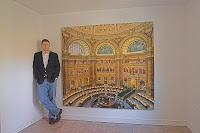Photopreneur is a blog that offers ideas, inspiration, and opportunities for photographers on how to market themselves and inventive ways to generate revenue from their photography. If you have never visited them before, you should check it out. You will be dizzy with ideas and might have several “Why didn’t I think of that?” moments after an hour of reading. It is a great resource for photographers.
 They had a feature on photographer Max Lyons. He specializes in gigapixel photography. He shot his first gigapixel image in 2003 of Bryce Canyon. Technology has helped speed up the once daunting task of merging the many shots taken to comprise the gigapixel image, he developed a software program called PTAssembler. The post has several tips if you are considering trying to create a gigapixel image of your own.
They had a feature on photographer Max Lyons. He specializes in gigapixel photography. He shot his first gigapixel image in 2003 of Bryce Canyon. Technology has helped speed up the once daunting task of merging the many shots taken to comprise the gigapixel image, he developed a software program called PTAssembler. The post has several tips if you are considering trying to create a gigapixel image of your own.
“The software I’ve created to produce these images (originally written in 2003) has no size constraint. From a purely technical standpoint, it would be a trivial matter to produce images of two, 20 or 200 gigapixels.”
Of course, it’s not quite that easy. Max points out that while his program has now cut the time to assemble a one gigapixel mosaic from several weeks to just two hours, most of which is automated, capturing each photo “tile” with a long focal-length lens can take “a considerable amount of time.” It took Max seventeen minutes with a six megapixel Canon D60 to shoot the 196 separate images that went into the Bryce Canyon panorama. That in turn creates problems with movement, changing light and depth of field, and can limit the range of subjects that can be shot using this method:
“In fact, if you look at the works of other high resolution photographers, you’ll see that most really large images (gigapixel and beyond) tend to be either (a) of interior, flat surfaces where depth of field, motion and lighting changes are not such problems, (b) scenes that look OK when viewed at tiny size, but have such a narrow depth of field that most of the image is hopelessly blurry when viewed at full size and/or (c) suffer from obvious misalignments and obvious lighting changes…”

What also impressed me about Max’s work is his choice for printing his gigapixel files. He uses a LightJet to print his highly detailed images. It is a perfect illustration of the power of the machine. You can read the title off of the books in this shot of the Library of Congress Reading Room. You can’t do that with an inkjet.










Leave A Comment